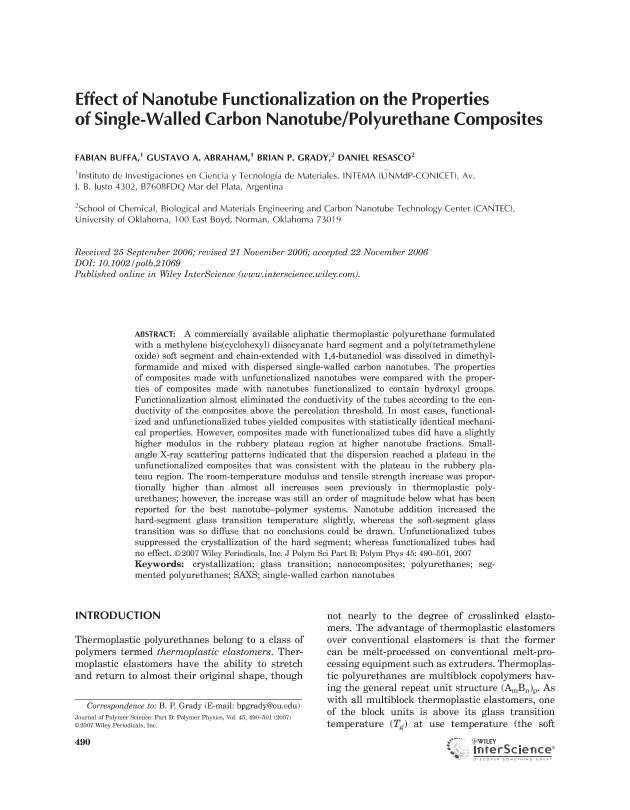Mostrar el registro sencillo del ítem
dc.contributor.author
Buffa, Fabián Alejandro

dc.contributor.author
Abraham, Gustavo Abel

dc.contributor.author
Brian P. Grady
dc.contributor.author
Daniel E. Resasco
dc.date.available
2019-02-22T20:05:50Z
dc.date.issued
2007-12
dc.identifier.citation
Buffa, Fabián Alejandro; Abraham, Gustavo Abel; Brian P. Grady; Daniel E. Resasco; Effect of Nanotube Functionalization on the Properties of Single-Walled Carbon Nanotube/Polyurethane Composites; John Wiley & Sons Inc; Journal of Polymer Science Part B: Polymer Physics; 45; 4; 12-2007; 490-501
dc.identifier.issn
0887-6266
dc.identifier.uri
http://hdl.handle.net/11336/70742
dc.description.abstract
A commercially available aliphatic thermoplastic polyurethane formulated with a methylene bis(cyclohexyl) diisocyanate hard segment and a poly(tetramethylene oxide) soft segment and chain-extended with 1,4-butanediol was dissolved in dimethylformamide and mixed with dispersed single-walled carbon nanotubes. The properties of composites made with unfunctionalized nanotubes were compared with the properties of composites made with nanotubes functionalized to contain hydroxyl groups. Functionalization almost eliminated the conductivity of the tubes according to the conductivity of the composites above the percolation threshold. In most cases, functionalized and unfunctionalized tubes yielded composites with statistically identical mechanical properties. However, composites made with functionalized tubes did have a slightly higher modulus in the rubbery plateau region at higher nanotube fractions. Small-angle X-ray scattering patterns indicated that the dispersion reached a plateau in the unfunctionalized composites that was consistent with the plateau in the rubbery plateau region. The room-temperature modulus and tensile strength increase was proportionally higher than almost all increases seen previously in thermoplastic polyurethanes; however, the increase was still an order of magnitude below what has been reported for the best nanotube-polymer systems. Nanotube addition increased the hard-segment glass transition temperature slightly, whereas the soft-segment glass transition was so diffuse that no conclusions could be drawn. Unfunctionalized tubes suppressed the crystallization of the hard segment; whereas functionalized tubes had no effect. © 2007 Wiley Periodicals, Inc.
dc.format
application/pdf
dc.language.iso
eng
dc.publisher
John Wiley & Sons Inc

dc.rights
info:eu-repo/semantics/openAccess
dc.rights.uri
https://creativecommons.org/licenses/by-nc-sa/2.5/ar/
dc.subject
Crystallization
dc.subject
Glass Transition
dc.subject
Nanocomposites
dc.subject
Polyurethanes
dc.subject
Saxs
dc.subject
Segmented Polyurethanes
dc.subject
Single-Walled Carbon Nanotubes
dc.subject.classification
Recubrimientos y Películas

dc.subject.classification
Ingeniería de los Materiales

dc.subject.classification
INGENIERÍAS Y TECNOLOGÍAS

dc.title
Effect of Nanotube Functionalization on the Properties of Single-Walled Carbon Nanotube/Polyurethane Composites
dc.type
info:eu-repo/semantics/article
dc.type
info:ar-repo/semantics/artículo
dc.type
info:eu-repo/semantics/publishedVersion
dc.date.updated
2019-02-05T14:13:43Z
dc.journal.volume
45
dc.journal.number
4
dc.journal.pagination
490-501
dc.journal.pais
Estados Unidos

dc.journal.ciudad
Nueva Jersey
dc.description.fil
Fil: Buffa, Fabián Alejandro. Consejo Nacional de Investigaciones Científicas y Técnicas. Centro Científico Tecnológico Conicet - Mar del Plata. Instituto de Investigaciones en Ciencia y Tecnología de Materiales. Universidad Nacional de Mar del Plata. Facultad de Ingeniería. Instituto de Investigaciones en Ciencia y Tecnología de Materiales; Argentina
dc.description.fil
Fil: Abraham, Gustavo Abel. Consejo Nacional de Investigaciones Científicas y Técnicas. Centro Científico Tecnológico Conicet - Mar del Plata. Instituto de Investigaciones en Ciencia y Tecnología de Materiales. Universidad Nacional de Mar del Plata. Facultad de Ingeniería. Instituto de Investigaciones en Ciencia y Tecnología de Materiales; Argentina
dc.description.fil
Fil: Brian P. Grady. University of Oklahoma; Estados Unidos
dc.description.fil
Fil: Daniel E. Resasco. University of Oklahoma; Estados Unidos
dc.journal.title
Journal of Polymer Science Part B: Polymer Physics

dc.relation.alternativeid
info:eu-repo/semantics/altIdentifier/doi/https://doi.org/10.1002/polb.21069
dc.relation.alternativeid
info:eu-repo/semantics/altIdentifier/url/https://onlinelibrary.wiley.com/doi/abs/10.1002/polb.21069
Archivos asociados
